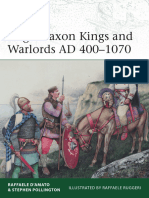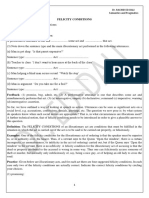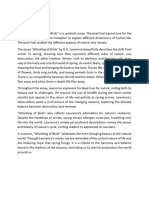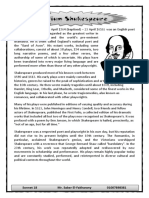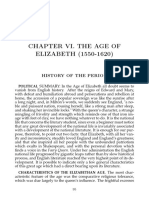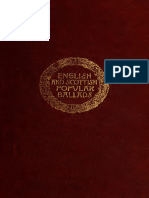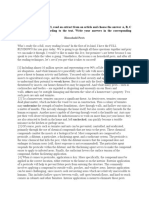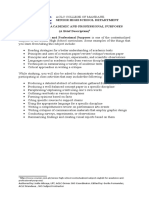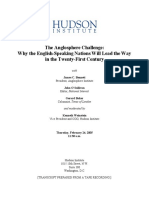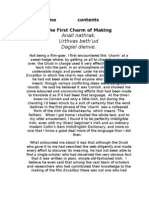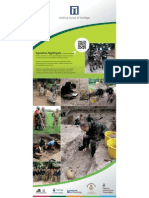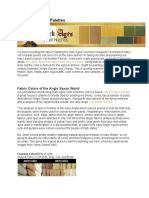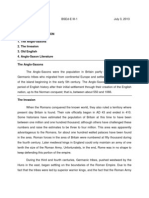Chapter One Anglo-Saxon Literature
Chapter One Anglo-Saxon Literature
Uploaded by
kubra kCopyright:
Available Formats
Chapter One Anglo-Saxon Literature
Chapter One Anglo-Saxon Literature
Uploaded by
kubra kOriginal Description:
Original Title
Copyright
Available Formats
Share this document
Did you find this document useful?
Is this content inappropriate?
Copyright:
Available Formats
Chapter One Anglo-Saxon Literature
Chapter One Anglo-Saxon Literature
Uploaded by
kubra kCopyright:
Available Formats
Chapter One Anglo-Saxon Literature
Chapter One
Anglo-Saxon Literature
I. Introduction
1. Anglo-Saxon Conquest
In the ancient times, there were three tribes called Angles, Saxons and
Jutes in the northern Europe. In the 5th century, they conquered Britain and
settled down there. After driving the native people into the deep mountains of
Wales and Scotland, they divided the whole island among themselves. Angles
settled down in the east midland, and built the kingdom of East Angles; Saxons
took the southern part of the island and set up some small kingdoms such
as Wessex, Essex and Sussex; Jutes occupied the southeastern corner of the
island. Gradually seven kingdoms arose in Britain. In the 7th century, these
small kingdoms were combined into a united kingdom called England.
Angles, Saxons and Jutes who are usually known as Anglo-Saxons are
the first Englishmen. The language spoken by them is called the Old English,
which is the foundation of English language and literature. With the Anglo-
Saxon settlement in Britain, the history of English literature began.
2. Characteristics of Anglo-Saxon Literature
Anglo-Saxon literature, that is, the Old English literature, was almost
exclusively a verse literature in oral form. It could be passed down by word
of mouth from generation to generation. Its creators for the most part were
unknown. It was given a written form long after its composition.
There were two groups of poetry in the Anglo-Saxon period. The first
group was the pagan poetry represented by Beowulf ; the second was the
religious poetry represented by the works of Caedmon and Cynewulf.
In the 8th century, Anglo-Saxon prose appeared. The famous prose writers
of that period were Venerable Bede and Alfred the Great.
1英国文学新编(修订版)第一部分(出片).indd 3 2010.12.6 5:31:48 PM
英国文学新编(修订版)
II. Anglo-Saxon Poetry
1. Pagan Poetry
Beowulf
Beowulf is the oldest poem in the English language. It is the most important
specimen of Anglo-Saxon literature, and also the oldest surviving epic in the
English language. It consists of more than 3,000 lines. It had been passed from
mouth to mouth for hundreds of years before it was written down in the 10th
century or at the end of the 9th century. The main stories in the poem are based
on the folk legends of the primitive northern tribes.
Hrothgar, king of the Danes, has built near the sea a mead-hall called
Heorot. It is the most splendid hall in the world. Every night the king and his
thanes gather there to feast and enjoy the songs of his gleemen. But later on
misfortunes befall them. One night, after they have gone to sleep, a frightful
monster called Grendel comes. He breaks into the hall, kills thirty of the
sleeping warriors, carries off their bodies and devours them in his lair under
the sea. The appalling visit speedily repeats, and fear and death reign in the
great hall. The king’s warriors fight at first, but flee when they find that no
weapon can hurt the monster. The splendid mead-hall is left deserted and
silent. For twelve winters Grendel’s horrible raids continue, and joy is changed
to mourning among the Danes.
Beowulf is the nephew of Hygelac, king of the Geats who live in Juteland,
Denmark. He is a great hero, noted for his strength and bravery. When he hears
that Hrothgar, the good friend of his uncle, is in great trouble, he determines to
help the unhappy king. Then he crosses the sea with 14 soldiers to rid Hrothgar
of the monster. When they get there, they are given a feast of welcome in the
hall, and then they lie down in the hall for the night. At midnight, Grendel
comes and kills one of Beowulf’s soldiers. Beowulf has a hand-to-hand fight
with him. Finally he wrenches off one of the monster’s arms. Then the monster
flees to his den and dies. The next night, Grendel’s mother descends upon
the hall to avenge her son. She carries away the king’s dearest friend. In the
morning, Beowulf chases her into her lair and slays her with a sword wrought
by the giants hanging on the wall. When he finds the corpse of Grendel, he
cuts off his head and brings it back triumphantly. The Danes award him many
treasures, and Beowulf returns to his uncle happily.
1英国文学新编(修订版)第一部分(出片).indd 4 2010.12.6 5:31:48 PM
Chapter One Anglo-Saxon Literature
Later on, Beowulf inherits the crown from his uncle and has reigned
over his kingdom for 50 years. He is a nice king loved and respected by his
people. But a disaster befalls his kingdom. A fire-spewing dragon that lives
on a mountain begins to devastate the land of his kingdom because it thinks
somebody has stolen a golden cup from the mountain cave that he has guarded
for 300 years. Therefore the angry dragon determines to punish the people
of the kingdom. It spews fire every day to burn the land and kill the people.
To save his people from the disaster, with 11 chosen warriors the aged king
goes to fight against the dragon. In the end, the dragon is killed, but Beowulf
is severely wounded during the battle. He dies a heroic death. The poem ends
with the scene of the grand funeral held for the hero by his people.
Writing Features of the Poem
1) It is not a Christian but a pagan poem, despite the Christian flavour
given to it by the monastery scribe who wrote it down. It is the product of
an advanced pagan civilisation. The whole poem presents to us an all-round
picture of the tribal society. The social conditions and customs can be clearly
seen in the poem. It helps us a lot when we study the primitive society of
Europe. So the poem has a great social significance.
2) The use of strong stresses and the predominance of consonants are
notable in the poetical lines. Each line is divided into two halves, and each half
is made to have two heavy stresses.
3) The use of alliteration is another notable feature of the poem. Three
stressed syllables of each line are arranged in alliteration, which makes the
whole line even more emphatic.
4) A lot of metaphors and understatements are used in the poem. For
example, the sea is called “the whale-road” or “the swan-road”; the soldiers are
called “shield-men”; the chieftains are called “treasure-keepers”; the human
body is referred to as “the bone-house”; God is called “wonder-wielder”; the
monster is referred to as “soul-destroyer”.
2. Religious Poetry
Caedmon
Caedmon (610-680) is the first known religious poet of England. He is
1英国文学新编(修订版)第一部分(出片).indd 5 2010.12.6 5:31:48 PM
英国文学新编(修订版)
known as the father of English songs. His life story is vividly described in
Bede’s Historia Ecclesiastica. Caedmon, who was a humble and unlearned
man, looked after cattle for an abbey on the Yorkshire coast. On the eve of the
New Year, a feast was held in the abbey. When songs were called for, he stole
out quietly, because he felt ashamed that he could contribute nothing to the
amateur entertainment. Then he lay down in the cowshed to sleep. In his sleep,
he heard a voice asking him to sing. “I can’t sing,” he said. “And that is why I
left the feast and came here.” “Nevertheless,” said the mysterious voice, “You
shall sing to me.” “What shall I sing?” asked Caedmon. “Sing me the song of
creation.” Then Caedmon sang a song, which became his first poem and was
named The Hymn of Praise. Later on, encouraged by the success of his first
poem, Caedmon composed many other poems by using the biblical material.
Cynewulf and His Poems
Cynewulf lived in the early 9th century. Except the unknown composer
of Beowulf, he is regarded as the greatest Anglo-Saxon poet. Of his life story
we know very little. He was probably an ecclesiastic and a scholar. His name
remained unknown until 1840.
He produced four poems: Christ, Juliana, The Fates of the Apostles, and
Elene.
Of all these poems the most characteristic is Christ, which is a didactic
poem in three parts: the first part celebrates the Nativity; the second part
describes the Ascension; and the third part deals with the Doomsday.
Cynewulf took his subject matter partly from the church liturgy, but more
largely from the homilies of Gregory the Great. The poem expresses a deep
love for Christ and reverence for Virgin Mary.
III. Anglo-Saxon Prose
Prose literature arrived later than poetry. It did not show its appearance
until the 8th century. There appeared three famous prose writers: Venerable
Bede, Alfred the Great and Aelfric.
1英国文学新编(修订版)第一部分(出片).indd 6 2010.12.6 5:31:49 PM
Chapter One Anglo-Saxon Literature
1. Venerable Bede
When we speak of the Old English prose, the first name that comes into our
mind is Venerable Bede (673-735), who is the first scholar in English literature
and has been regarded as the father of English learning. His works, over 40
in number, were written exclusively in Latin and covered the whole field of
human knowledge of his day.
The most important of his works is The Ecclesiastical History of the
English People. The book not only tells us how religion was introduced and
spread in England but also recounts some historical events of that period as
well as some Anglo-Saxon mythological legends. It is in this book that Bede
describes Caedman’s legendary life story.
2. Alfred the Great
Alfred the Great (848-901), king of Wessex kingdom, is another important
figure in prose writing of Anglo-Saxon period. During his reign, he tried every
means to improve education by founding colleges and importing teachers from
Europe. He was a well-known translator. He translated some important Latin
works into English, among which, the most important is The Anglo-Saxon
Chronicle. This book records the main happenings of the Anglo-Saxon period.
It is the best monument of the Old English prose.
3. Aelfric
Aelfric (955-1010) was a clergyman. He wrote a large number of religious
works in Greek and Latin. In his works he introduced a lighter, clearer and
more musical prose, and the Old English prose was attaining high quality.
1英国文学新编(修订版)第一部分(出片).indd 7 2010.12.6 5:31:49 PM
英国文学新编(修订版)
Exercise 1
I. Choose the best answers to complete the sentences.
1. Anglo-Saxon conquest happened in the .
a. 5th century b. 7th century c. 9th century
2. The first Englishmen are .
a. Angles and Saxons b. Angles and Jutes c. Anglo-Saxons
3. The history of English literature began with .
a. Anglo-Norman conquest b. Anglo-Saxon settlement in Britain
c. the appearance of Beowulf
4. is the most important specimen of Old English literature.
a. Historia Ecclesiastica b. The Hymn of Praise c. Beowulf
5. The main stories of Beowulf are based on the folk legends of .
a. the Bible b. the primitive northern tribes
c. Anglo-Saxons
6. Beowulf presents an all-round life picture of the .
a. feudal society b. tribal society
c. bourgeois society
7. The use of is a notable feature of Beowulf.
a. alliteration, metaphors and understatements
b. strong stresses and predominance of consonants
c. all of the above
8. The first known religious poet in England is .
a. Caedmon b. Cynewulf c. Venerable Bede
1英国文学新编(修订版)第一部分(出片).indd 8 2010.12.6 5:31:49 PM
Chapter One Anglo-Saxon Literature
9. When we talk about the Old English prose the first name that comes into
our mind is .
a. Alfred the Great b. Aelfric c. Venerable Bede
10. is Alfred the Great’s most important contribution to the Old
English prose literature.
a. The Ecclesiastical History of the English People
b. Historia Ecclesiastica c. The Anglo-Saxon Chronicle
II. Check the statements T (True) or F (False).
1. After Anglo-Saxon conquest, seven small kingdoms appeared
in Britain and later they were combined into a united kingdom
named England.
2. Anglo-Saxon literature is exclusively a prose literature in oral
form.
3. English poetry in the Anglo-Saxon period falls into two groups:
non-religious and religious.
4. Beowulf is the oldest surviving epic in the English language.
5. Beowulf reflects how people in the tribal society fought against
nature.
6. Caedmon’s legendary life story is described by Bede in The
Anglo-Saxon Chronicle.
7. Historia Ecclesiastica describes how religion was introduced and
spread in England.
8. Venerable Bede is the first scholar in English literature and has
been regarded as the father of English learning.
9. The Ecclesiastical History of the English People is the best
monument of the Old English prose.
10. Cynewulf took his poetical subject matter partly from the church
liturgy, but more largely from the homilies of Gregory the Great.
1英国文学新编(修订版)第一部分(出片).indd 9 2010.12.6 5:31:49 PM
英国文学新编(修订版)
III. Explain the following terms.
1. Epic
2. Alliteration
3. Pagan poetry
4. Verse
5. Prose
IV. Answer the following questions.
1. What are the characteristics of Anglo-Saxon literature?
2. Briefly tell the story of Beowulf.
3. What are the writing features of Beowulf ?
4. What is the theme of Beowulf ?
10
1英国文学新编(修订版)第一部分(出片).indd 10 2010.12.6 5:31:49 PM
Chapter Two Medieval English Literature
Chapter Two
Medieval English Literature
I. Anglo-Norman Literature
1. Introduction
Norman Conquest
The Normans was originally a hardy race of sea rovers living in
Scandinavia. In the l0th century, they conquered a part of northern France,
which has been called Normandy, and settled down there. They adopted French
as their language and embraced Christianity. They became renowned for their
learning, their military prowess and their organising ability.
The Duke of Normandy William the Great was an able military leader and
statesman. In the year 1066, he led the Norman army to attack England. The
two armies met and fought at Hastings. Finally the English army was defeated.
William and his men marched speedily into London and William became the
King of England.
After the conquest, feudal system was established in English society. The
new king ruled England with a high hand. He made a thorough job of taking
over the country, and had everything inventoried. William saw himself as the
owner of the country. He owned the land and everything in it. The feudal social
structure in England was just like the pyramid in Egypt. At its top was the King
William and below him were his noblemen such as barons and knights.
Social Conditions in the Feudal England
In the feudal society, class division was very obvious, and class
contradictions became very sharp. The peasants, who had become serfs, toiled
all the year round for the feudal landlords. The church and court were united
to control and oppress the people. Those who dared to say anything against
the feudal order would be put to death. Moreover, continuous wars with other
countries and diseases added miseries to the English people. The government
had no sympathy with the people. Instead, they enforced heavy taxes upon
11
1英国文学新编(修订版)第一部分(出片).indd 11 2010.12.6 5:31:50 PM
英国文学新编(修订版)
the people. The poor peasants could not endure any longer, and they rose up
to fight against the ruling class. The year 1381 witnessed a famous peasant
uprising led by Wat Tyler and John Ball. Though it failed and its leaders were
killed, it gave the ruling class a heavy blow.
The Influence of the Norman Conquest upon English Language and
Literature
After the conquest, the Normans introduced the body of customs and ideals
known as chivalry into England. The knightly code, the romantic interest
in women, tenderness and reverence paid to Virgin Mary were reflected in
literature.
With the coming of the Normans, the Anglo-Saxons sank to a position
of abjectness. Their language was made a despised thing. French words of
warfare and chivalry, art and luxury, science and law, began to come into the
English language. Thus three languages existed in England in that period. The
Normans spoke French, the lower classes spoke English, and the scholars and
clergymen used Latin.
The literature of that period was varied in interest and extensive in
range. The Normans began to write histories or chronicles to record their
achievements. Most of the books were written in Latin or French.
The prevailing form of literature in the feudal England was the romance.
2. The Romance in the Anglo-Norman Period
Essential Features of the Romance
The romance was the prevailing literary form in the medieval period. It
was a long composition, sometimes in verse and sometimes in prose, which
described the life and adventures of a noble hero. Its essential features are the
following:
1) It lacks general resemblance to truth or reality.
2) It exaggerates the vices of human nature and idealises the virtues.
3) It contains perilous adventures more or less remote from ordinary life.
4) It lays emphasis on supreme devotion to a fair lady.
5) The central character of the romance is the knight, a man of noble birth
12
1英国文学新编(修订版)第一部分(出片).indd 12 2010.12.6 5:31:50 PM
Chapter Two Medieval English Literature
and skilled in the use of weapons, who is commonly described as riding forth
to seek adventures, or taking part in tournaments, or fighting for his lord in
battle. He is devoted to the church and the king.
In romances we see an epitome of the English society in the medieval
period. The romance, as a literary genre, prospered for about 300 years
(1200-1500). It was written for the upper class, so it had little to do with the
common people.
Romance Cycles
A large number of romances fall into three cycles or three groups according
to the subject matters: the matter of Britain, the matter of France, and the
matter of Rome.
1) The matter of France deals largely with the exploits of Charlemagne,
usually known as Charles the Great, King of the Franks and Emperor of the
West Empire. The famous romance of this group is La Chanson de Roland.
2) The matter of Rome deals with tales from Greek and Roman sources.
Alexander the Great (356-323 B.C.), King of Macedonia and conqueror of
Greece, Egypt, India and Persian Empire is the favourite hero of this group.
Besides this, Trojan War is also dealt with in this group.
3) The matter of Britain mainly deals with the exploits of King Arthur and
his Knights of the Round Table. The most interesting of all Arthurian romances
are those of the Gawain cycle. The story of Sir Gawain and the Green Knight
is the culmination of the Arthurian romances.
Sir Gawain and the Green Knight
It is a verse-romance of 2,530 lines, derived from Celtic legends. Here is
the story:
On a New Year’s Eve, King Arthur and his knights are holding a feast for
the arrival of the New Year. A giant dressed in green enters the banquet hall
on horseback with a battle-axe in his hand. This big man comes to challenge
any knight in the hall to give him a blow with the battle-axe. The condition is
that a return stroke be permitted a year later at the Green Chapel. No knight in
the hall dares to accept the challenge. Seeing this, the King feels ashamed and
angry, and he stands up and wants to accept the challenge himself. Just then,
the King’s nephew Gawain stands up and he takes up the challenge. With one
13
1英国文学新编(修订版)第一部分(出片).indd 13 2010.12.6 5:31:50 PM
英国文学新编(修订版)
blow he sends the giant’s head rolling through the floor of the hall. But the
Green Knight, who is evidently a terrible magician, does not fall and die. He
picks up his head and mounts his horse. He holds out his head and the ghastly
lips warn Gawain to be faithful to his promise and to seek through the world
till he finds the Green Chapel, where on the next New Year’s Day, the Green
Knight will meet him and return the blow.
A year has passed. Sir Gawain leaves his uncle to look for the Green
Chapel and the Green Knight. He goes through a lot of hardships and
adventures on the way. But he cannot find the chapel or the knight.
On the Christmas Day, he loses his way in a forest. Then he kneels down
to pray to Mary for help. After the prayers, a great castle appears on the hill
before him. He goes up to the castle and is warmly entertained by the host and
hostess. Gawain is told that the Green Chapel is not far away. And he is asked
to have a three-day rest in the castle.
Gawain stays there for three days. The host makes a compact with him.
According to the compact, the host goes out hunting each day, and Gawain
stays in the castle to entertain the beautiful hostess. In the evening they should
exchange what they have got during the day.
On the first day, the host goes hunting, and Gawain stays in the castle. The
beautiful hostess tries to tempt him to make love with her, but is refused by
Gawain. Then she gives Gawain a kiss. When the host returns in the evening,
he gives his guest the game he killed, and Gawain gives him the kiss he got
from the lady. On the second day, Gawain also receives a kiss from the hostess,
and he gives it back to the host when he comes back. On the third day, the
lady not only gives Gawain a kiss but also offers him a ring. Gawain refuses to
accept the ring. Then the hostess wants him to accept a magic green girdle and
tells him that the girdle will protect him from any injury if he wears it. Gawain
accepts the girdle and promises to the lady not to tell anybody about it. When
the host comes back in the evening, Gawain only gives back the kiss he got
from the hostess but he does not say anything about the girdle.
Three days later, the host takes Gawain to the Green Chapel. As soon as
they get there, the host disappears and Gawain is left alone. He finds that the
chapel is a terrible place. When he approaches it, he hears a terrifying sound.
Obviously the green giant is sharpening his new axe. Then the Green Knight
14
1英国文学新编(修订版)第一部分(出片).indd 14 2010.12.6 5:31:50 PM
Chapter Two Medieval English Literature
comes out from the chapel with an axe, and Gawain offers his neck for his
blow. Twice he is not injured at all, and the third blow of the axe falling upon
his shoulder gives him a slight wound.
Then the Green Knight tells Sir Gawain that he is none other than the host
of the Castle where Gawain stayed for three days. He says to Gawain that the
first two blows of the axe did not injure Gawain because he was true to the
compact and twice returned the kiss. The last blow wounded him because he
concealed the green girdle. Full of shame, Gawain throws back the girdle and
is ready to atone for his deception. But the Green Knight thinks that he has
already atoned, so he lets Gawain keep the girdle as a gift from him.
When Gawain comes back to his kingdom, his story becomes widely
known. In order to let his knights remember this shameful thing and draw a
lesson from it, King Arthur gives a command to his knights that each of them
wears a green girdle.
This romance is one of the most delightful old romances in any language.
In form, it is an interesting combination of French and Saxon elements. It is
written in an elaborate stanza combining metre and alliteration. At the end of
each stanza there is a rhymed refrain.
II. English Literature in the Age of Chaucer
1. Introduction
Chaucer lived in the 14th century. In that century, England produced five
main writers. The first one was William Langland, who wrote about social
discontent in his works and preached the equality of men and dignity of labour.
Wycliffe, the second one, was the greatest of English religious reformers
and the first translator of the Bible. Gower, the third one, was a scholar and
a literary man, who criticised the social evils in his works. The fourth one
Mandeville was a traveller, who wrote about the wonders he had seen abroad.
Chaucer, the last one and the greatest of them, was a scholar, a traveller, a
businessman and a courtier, who shared all the stirring life of his age in his
works. He was the representative writer of the century. Therefore, the 14th
century is usually called the Age of Chaucer. Chaucer and Langland are two
most important writers of the age.
15
1英国文学新编(修订版)第一部分(出片).indd 15 2010.12.6 5:31:50 PM
英国文学新编(修订版)
2. William Langland
Introduction
William Langland (c.1330-c.1400) was born in the western midland of
the country. He was educated in the school of a monastery at Malvern. After
school he took minor orders, but never rose in the church. Then he moved to
London and made a scanty living by singing masses, copying legal documents
and doing other odd jobs. In 1362, he began writing his famous poem Piers
Plowman, which was repeatedly revised. Three texts of the poem have been
left to us, from which we see that it is written in the old alliterative verse: each
line contains three alliterated words, two of which are placed in the first half,
and the third in the second half.
Piers Plowman
The poem describes a series of wonderful dreams the poet-speaker has
dreamed. Through these dreams, we see a picture of life in the feudal England.
In the first dream, the author sees before him a fair field full of people. There
are the rich and the poor, workers and idlers, nobles and merchants, unworthy
priests, pardoners and jesters. All classes are there. The working people are
working hard to plough and sow, but the idlers waste their labour fruit.
The speaker also finds all sorts of parasites. Among them are bishops and
deacons, who, instead of preaching to their flocks, become the clerks of the
law court. Rule of the Church is given to the cardinals who possess no cardinal
virtues at all. There are also other religious idlers called friars, monks, hermits,
and the like. All of them tell lies to the people, but a lot of money falls into
their pockets.
In his dream, the speaker also notices a group of rats rush upon the scene.
They discuss how to get rid of a court cat. One rat proposes that their enemy
should be killed. But a mouse says that, even if the cat is killed, another will
come in its place. So at last, all of the rats say: “Let that Cat Be.” By using the
fable story of the rats, the author exposes the ugly features of the ruling class
and sums up the political situation of the time.
In the next dream, the speaker finds Lady Bribery, who is the incarnation
of the corruption of the ruling class, and the enemy of Truth. Lady Bribery is
going to be married to a man called False Fickle-Tongue. Through the allegory
16
1英国文学新编(修订版)第一部分(出片).indd 16 2010.12.6 5:31:51 PM
Chapter Two Medieval English Literature
of her marriage, those who are connected with the royal and ecclesiastical
court are brought under the lash. The King is enraged at the news of the
marriage. And Lady Bribery is asked by the King to wed Conscience. But
when Conscience is called to the court, he flatly refuses to marry the lady and
sets forth her whole manner of life. Conscience says that Bribery has corrupted
the judges, and made it difficult for the poor to get justice. She releases the
guilty, throws the just into prison, and hangs the innocent; and she is privy with
the Pope, and lives secretly with priests as their concubine. When Lady Bribery
is asked to defend herself against these charges, she makes an extremely
cunning speech. She says that her intervention in all the relations of life is very
necessary and important, and she makes the relationships between master and
servant, King and subject, buyer and seller go well. Conscience exposes her
fallacies point by point. He says there are two kinds of bribery, one the just
reward for service, the other the price of misdoing. What labourers receive is
not bribery, but wages; in merchandise, there is not bribery, but exchange.
Lady Bribery has no argument to offer but a misquotation from the
Scriptures. She says Solomon declared that those who gave gifts won victory
and obtained honour. But Conscience at once reminds her that she has left out
the last part of the text: “He that giveth a gift shall have honour, but the soul
of them that receive it is bound thereby.” Finally, the King bids them to be
reconciled.
Here we can see clearly that the poet tries to lash the corruption of the
ruling class and the church with the whip of a satirist. And he also describes
the hard life of the poor peasants and shows sympathy to them.
The next part of the poem describes the pilgrimage of the people in search
for Truth.
In the confusion, Lady Holy Church appears. She encourages all the people
to seek Truth, which is the best thing in the world. But the people say that they
can never find the way without a guide, whereupon appears on the scene the
hero of the poem, Piers the plowman. Piers the plowman is a simple and honest
peasant. Before guiding the people on their pilgrimage, he says that he must
first have his half-acre land ploughed. So he sets all the pilgrims to work in his
field. He explains to the people that the best way to find Truth is to take part in
labor. In this part, the author praises the dignity of honest labour. He considers
that the hard-working farmers are the nearest to Truth.
17
1英国文学新编(修订版)第一部分(出片).indd 17 2010.12.6 5:31:51 PM
英国文学新编(修订版)
Social Significance of Piers Plowman
Piers the plowman, the hero of the story, is not a representative of the poor
peasants. He is one of the well-to-do peasants. He has no intention of upsetting
the feudal order of society, and he accepts the existing social relations. This is
the limitation of the poem. In spite of that, Piers Plowman remains a classic
in popular literature. It praises the poor peasants, and condemns and exposes
the sins of the oppressors. It was very popular in the 14th and 15th centuries. It
played an important part in arousing the revolutionary sentiment on the eve of
the uprising of 1381 headed by Wat Tyler and John Ball. It gives us a realistic
social picture of medieval England.
Artistic Features of the Poem
1) Piers Plowman is written in the form of a dream vision. The author tells
the stories under the guise of having dreamed them.
2) The poem is an allegory that relates truth through symbolism.
3) The poet uses indignant satire in his description of social abuses caused
by corruption prevailing among the ruling classes, ecclesiastical and secular.
4) The poem is written in alliteration.
3. Geoffrey Chaucer
Introduction
Today Chaucer (c.1343-1400) is acclaimed not
only as the father of English poetry but also as the
father of English fiction. We are indebted to him
for the most vivid contemporary description of
England in the medieval period.
Chaucer’s whole life can be divided into three
periods. The first period, about 30 years, including
his youth and early manhood, is the period of
French influence. Chaucer’s main works in this
period were translations from French. Chaucer
Geoffrey Chaucer
translated The Romaunt of the Rose, the most
popular poem of Middle Ages, from French into English. The second period,
about 15 years, covers Chaucer’s active life as a diplomat and man of affairs. In
18
1英国文学新编(修订版)第一部分(出片).indd 18 2010.12.6 5:31:51 PM
Chapter Two Medieval English Literature
this period, Italian influence seemed to be stronger than the French. The major
works by Chaucer in this period were adaptations from Italian writers. His
masterwork of this period was Troilus and Criseyde. The third period, covering
his last 15 years, is generally known as the English period. It is the period of
Chaucer’s richest development. His masterpiece, The Canterbury Tales, one of
the most famous works in all literature, fills the third period. In this great work,
the author gives his reader a picture of English society in Middle Ages.
The Canterbury Tales
The whole book consists of a prologue and 24 tales. In the prologue, the
author reveals his plan for writing this work, and also vividly describes some
30 taletellers.
The prologue tells us that one day in spring the author comes into the
Tabard Inn in Southwark at the south end of London Bridge. Here he meets
some 29 pilgrims, who are going to Canterbury. Then he joins this company,
which includes all the classes of English society. At supper, the host of the
inn suggests that in order to enliven the journey, each of the pilgrims tell two
stories on the going journey and another two on the returning journey. The
best storyteller shall be treated with a fine supper at general expense when they
come back. The host will be the judge of the contest.
According to the number of persons in the company, 31, evidently the
author planned to produce an immense work of 124 tales. Actullay only 24
were written before Chaucer’s death. These tales were written in various forms
of medieval literature: romances of knights and ladies; folk tales; animal fables;
stories of travels and adventures; legends, allegories and so on. Twenty-two
tales were written in verse form and only two in prose form.
The prologue comprises a group of vivid sketches of typical medieval
figures. The 30 pilgrims depicted by Chaucer represent all classes of the
English feudal society, except the royalty and the poorest peasants. They range
from the knight and squire, and prioress, through the landed proprietor and
wealthy tradesman, down to the drunken cook and humble plowman. There are
also a doctor, a lawyer, monks of different orders, nuns, priests, a summoner,
a sailor, a miller, a carpenter, a yeoman (a small independent farmer), and an
Oxford scholar. In the centre of the group is the Wife of Bath, the owner of a
large cloth-making factory.
19
1英国文学新编(修订版)第一部分(出片).indd 19 2010.12.6 5:31:52 PM
英国文学新编(修订版)
Every figure is drawn with the accuracy of a portrait. The portraits of
the 30 pilgrims supply a miniature of the English society in Chaucer’s time.
Looking at the picture gallery, we know at once how people lived in that era.
Therefore, Gorky, the Russian writer, regarded Chaucer as “the founder of
English realism”.
Let’s see how Chaucer draws the portrait of the Wife of Bath.
The Wife of Bath is the owner of a cloth-making factory, who is light-
hearted, merry, somewhat vulgar, and exceedingly talkative. Somebody in the
party urges her to talk about her husband, and she then tells the whole story
of her married life. She has married five husbands and she expects one or two
more. She says that she has always been able to master her husband and rule
the house. Sometimes she manages it by making her husband jealous, sometimes
she manages it because the husband is old and she is young and pretty. There
is only one husband whom she cannot easily dominate. He treats her badly.
But she gets the upper hand of her husband by provoking him to beat her and
then pretending to be dead. By using this trick she easily gets all the property
into her hand. For all she has done she justifies herself by quoting texts from
the Bible in the most extraordinary way and with the most extraordinary
comments. Thus we see a very vivid sketch of a woman of the middle class,
and a colourful picture of the domestic life of that class in Chaucer’s day.
The tales that the pilgrims tell are well suited to their various characters.
Among the 24 tales, the best ones are the tales told by the Knight, the Pardoner,
the Nun’s Priest and the Wife of Bath.
➊ The Knight’s Tale
Palamon and Arcite are two young Theban knights. They are cousins and
sworn-brothers. In a battle, both of them are found wounded on the battlefield.
So they are taken prisoners by the Duke of Athens. One day from the prison
window they behold the fair maid Emily, who is the sister-in-law of the
Duke. Both of the young men fall desperately in love with the lady. For this
reason their friendship ruptures. To decide who should marry the lady, a grand
tournament is held.
Arcite, who has prayed to God of war, Mars, wins. But unfortunately he
is thrown off the horse and dies, thus losing the lady in the very hour of his
triumph. Palamon, who has prayed to Venus, Goddess of love, marries Emily
20
1英国文学新编(修订版)第一部分(出片).indd 20 2010.12.6 5:31:52 PM
Chapter Two Medieval English Literature
after much sorrow.
The subject matter of the story was borrowed from Boccaccio’s tales. It is
one of the best tales in the book.
➋ The Pardoner’s Tale
Once upon a time, there are three rioters in Flanders, who do nothing every
day but drink, gamble and play cards and dice day and night. One day while
they are sitting in a tavern drinking, they see some men carrying a coffin pass
by. They are told that Death has killed many people in the village nearby. The
three rioters decide to find Death in order to slay him. So they set out to look
for Death. On their way to the village they meet an old man who directs them
in their search. But finally instead of meeting Death, they find under an oak tree
a heap of golden florins. In order to celebrate the happy finding the youngest is
sent to town to buy bread and wine. While the other two are waiting for him,
they make a plan to murder him when he comes back. When the youngest
arrives in town, an evil idea comes into his mind. He thinks if he puts his two
companions to death he will possess the heap of gold. So he buys some poison
and puts it into the wine. When he comes back, his two companions kill him
just as they have planned. Then the two murderers sit down to eat and drink.
Both die of poison. At last all the three rioters find Death as they wished.
➌ The Merchant’s Tale
The 60-year-old Baron January has become blind; his young wife May
and her lover take advantage of his blindness to make love in a tree. At that
moment, Pluto restores the old man’s eyesight, and he sees what is happening
before him. But realising that nothing can be done about it, the Baron accepts
his wife’s statement that his eyes have deceived him.
Social Significance of The Canterbury Tales
In his masterpiece The Canterbury Tales, Chaucer gives us a true-to-life
picture of the society of his time. Taking the stand of the rising bourgeoisie, he
affirms man’s right to pursue happiness and opposes the dogma of asceticism
preached by the church. As a forerunner of humanism, he praises man’s energy,
intellect, quick wit and love of life. His tales expose and satirise the social evils
of his time. They condemn the degeneration of the noble, the heartlessness of
the judge and the corruption of the church.
21
1英国文学新编(修订版)第一部分(出片).indd 21 2010.12.6 5:31:52 PM
英国文学新编(修订版)
Living in a transitional period, Chaucer is not entirely devoid of medieval
prejudices. He is religious himself. There is nothing revolutionary in his
writing, though he lived in a period of peasant uprising. When praising man’s
spirit to pursue earthly happiness, he sometimes likes to crack a rough joke and
paint naturalistic pictures of sexual life. These are Chaucer’s weak points. But
these are, however, of secondary importance compared with his achievement
as a great poet and storyteller.
Features of Chaucer’s Writing
Chaucer uses vivid and exact words. His poetry is full of vigour and
swiftness. Chaucer’s great contribution to English poetry is that he introduced
from France the rhyming couplet of iambic pentameter (which was later called
the “heroic couplet”) to English poetry, and used it in his masterwork. This
poetical form gradually took the place of the old alliterative verse form in
Chaucer’s day. Chaucer is the first great poet who wrote in the current English
language. He wrote his poetry using the east midland dialect of England,
the dialect of London. So he did much in making the dialect of London the
foundation of modern English speech, and in establishing English as the
literary language of the country.
Chaucer’s style in The Canterbury Tales is remarkably flexible. His prose,
like his vocabulary, is easy and informal. Chaucer is a great satirist, but his
satire is not bitter when he pokes fun at the foibles and weaknesses of people.
III. English Literature in the 15th Century
The 15th century was a period of general unrest. People’s attention was
drawn to a series of wars, and many nobles who had been patrons of arts and
literature were killed on the battlefield. The continuous wars greatly impeded
the development of literature. So the 15th century has traditionally been
described as the barren age of English literature.
Yet in this barren age, popular literature became very prosperous. There
were ballads, lyrics, popular dramas and so on. Popular ballads became the
most important form of English literature in this century. The appearance of
a large number of ballads made the 15th century the spring tide of English
22
1英国文学新编(修订版)第一部分(出片).indd 22 2010.12.6 5:31:52 PM
Chapter Two Medieval English Literature
ballads. This century produced one important writer whose name is Thomas
Malory.
1. English and Scottish Ballads
Popular Ballads
Popular ballads are originally dance songs. They are little stories in verse
form, which can be sung or recited by the common people. The origin of the
English and Scottish ballads is obscure. Usually they are anonymous, and are
handed down orally for many generations. They are simple and crude in story
and highly condensed and dramatic in presentation. In the 15th century, there
were several kinds of ballads: historical, legendary, fantastical, lyrical and
humourous. Popular ballads were found all over Europe in that period, but a
particularly fertile soil was the border area between England and Scotland, for
once many bloody battles were fought between the English and Scots there.
Ballads of Robin Hood
The most famous cycle of English ballads centres on the stories of a
legendary outlaw called Robin Hood. In English history, Robin Hood is a
partly real and partly legendary figure. The ballad stories tell us that he lives
during the reign of Richard I. He is the leader of a band of outlaws who live
in a big forest. They often attack the rich, and wage war against bishops and
archbishops, but they help the poor people. Therefore Robin Hood and his
followers are constantly hunted by the sheriffs. In the people’s mind, Robin
Hood becomes the symbol of rebellious and justice. So a lot of ballads dealing
with his adventures and rebellious spirit were composed in this period to
express people’s love and praise of Robin Hood and his men.
2. Thomas Malory
Introduction
Thomas Malory (1405-1471) is the only important prose writer in the
fifteenth century. He wrote an important book called Le Morte d’Arthur
(The Death of Arthur) in a prison cell. The charges against him ranged from
extortion, robbery and cattle rustling, to “waylaying the Duke of Buckingham”.
23
1英国文学新编(修订版)第一部分(出片).indd 23 2010.12.6 5:31:53 PM
英国文学新编(修订版)
It is possible, however, that few of the crimes were real. He was, after all,
a Lancastrian in a time of Yorkist ascendancy, and the law is ever a ready
weapon to those in power. In fact, when two general amnesties were declared
by King Edward VI in 1468, Malory, unlike the other prisoners in jail at the
time, was not set free. This may indicate that Malory had been singled out as a
particular enemy by the Crown because of his opposing role in the Wars of the
Roses.
Le Morte d’ Arthur
Malory’s tale begins with the mysterious birth of Arthur and ends with his
equally mysterious death. The major concern is with the adventures of Arthur
and his famous Knights of the Round Table. His knights have fought many
battles and won a lot of glory, all of which is a credit to the name of King
Arthur.
Near the end of the story, however, the tide of good fortune turns.
Launcelot, one of Arthur’s knights, falls in love with Arthur’s queen,
Guinevers, and the lady returns his love. One by one the other knights become
discontented, selfish, or disillusioned. Thus the kingdom is weakened, and
is attacked by the force under Sir Mordred, Arthur’s treacherous nephew.
Ultimately it goes down in defeat. Arthur is borne away on a barge by three
mysterious ladies of the lake.
Le Morte d’ Arthur was written in a time of transition. The feudal order was
collapsing. By the time Malory began writing his story, soldiers were fighting
with gunpowder, a middle class of tradesmen was arising, and the practices of
chivalry were being superseded by a new aristocratic code. Malory, in a desire
to escape the disorder and uneasiness of his day, tried to recapture the lost
ideals of the romantic past as recounted in his tale of noble kings, adventurous
knights, and damsels in distress.
This book is very important in English literature, for its Arthurian materials
give later writers sources of Arthurian stories.
24
1英国文学新编(修订版)第一部分(出片).indd 24 2010.12.6 5:31:53 PM
You might also like
- Anglo-Saxon Kings & Warlords AD 400-1070Document65 pagesAnglo-Saxon Kings & Warlords AD 400-1070brunoxcv99100% (3)
- Anglo SaxonsDocument38 pagesAnglo SaxonsThomas Jennings100% (1)
- British DialectsDocument49 pagesBritish Dialectsarmaniso100% (1)
- Saga - Northern FuryDocument27 pagesSaga - Northern FuryMaltsev Maxim100% (5)
- Lectures in English Literature 2015-2016Document39 pagesLectures in English Literature 2015-2016lenaNo ratings yet
- Caucasian Answers 1Document12 pagesCaucasian Answers 1Godfrey MuchaiNo ratings yet
- The Dover Mail: Answer The Following QuestionsDocument5 pagesThe Dover Mail: Answer The Following QuestionsMarwa MohNo ratings yet
- A Comparative Study of Light Verbs in Tamil and TuluDocument4 pagesA Comparative Study of Light Verbs in Tamil and TuluEditor IJTSRDNo ratings yet
- MAEL - 201 UOU Solved Assignment MA17-English (Final Year) 2019Document13 pagesMAEL - 201 UOU Solved Assignment MA17-English (Final Year) 2019ashutosh lohani100% (3)
- Three Men in A BoatDocument71 pagesThree Men in A BoatNatalia NesterovaNo ratings yet
- Philip Larkin's Concept of Time As Projected in His Poetry: A Brief AnalysisDocument5 pagesPhilip Larkin's Concept of Time As Projected in His Poetry: A Brief AnalysisNethuli KiaraNo ratings yet
- Chaucer's Poetry Falls Into Three Rather Clearly Marked PeriodsDocument5 pagesChaucer's Poetry Falls Into Three Rather Clearly Marked PeriodsКристина НабережнаяNo ratings yet
- We Are Seven William WordsworthDocument24 pagesWe Are Seven William WordsworthBianca Maria FurtosNo ratings yet
- REPORT Great Expectation by Charles DickensDocument9 pagesREPORT Great Expectation by Charles DickensK-pop. Fan.No ratings yet
- Shakespeare WorkDocument4 pagesShakespeare WorkMilena PelosiNo ratings yet
- Biography of John Milton.Document2 pagesBiography of John Milton.Abdullah IbrahimNo ratings yet
- The Canterburry Tales: Liberty Edition SummaryDocument2 pagesThe Canterburry Tales: Liberty Edition SummaryLuigi RossiNo ratings yet
- Shakespeare ReportDocument5 pagesShakespeare Reportapi-275033668No ratings yet
- Alfred LOrd Tennyson Finish BiographyDocument5 pagesAlfred LOrd Tennyson Finish BiographyIda Nurhayati GunawanNo ratings yet
- 6.the EnlightenmentDocument16 pages6.the EnlightenmentMariana VasilievNo ratings yet
- 16th and 17th Century Poetry (Level 3)Document11 pages16th and 17th Century Poetry (Level 3)lalyita100% (1)
- Pebbles On The Shore (By) Alpha of The Plough by Gardiner, A. G. (Alfred George), 1865-1946Document106 pagesPebbles On The Shore (By) Alpha of The Plough by Gardiner, A. G. (Alfred George), 1865-1946Gutenberg.orgNo ratings yet
- English LiteratureDocument43 pagesEnglish LiteratureJose AgurtoNo ratings yet
- Felicity ConditionsDocument5 pagesFelicity ConditionsRachid Issaoui100% (2)
- Noun Clauses: - Practice 1Document1 pageNoun Clauses: - Practice 1Tamzid ZamanNo ratings yet
- Research Proposal English LitDocument5 pagesResearch Proposal English LitTeodora Irina PolosanNo ratings yet
- English Model Question For Class Eight PDFDocument3 pagesEnglish Model Question For Class Eight PDFMuntasir MamunNo ratings yet
- Renaissance Short QsDocument4 pagesRenaissance Short QsMd Masud RanaNo ratings yet
- Robinson CrusoeDocument4 pagesRobinson CrusoeDebora PanzarellaNo ratings yet
- "A Psychoanalytical Study of The Tragic History of DR Faustus" by Christopher Marlow"Document18 pages"A Psychoanalytical Study of The Tragic History of DR Faustus" by Christopher Marlow"Israr KhanNo ratings yet
- Heroism in BeowulfDocument6 pagesHeroism in BeowulfveritoNo ratings yet
- The Stuarts. The Crown and ParliamentDocument3 pagesThe Stuarts. The Crown and ParliamentNatalia BerehovenkoNo ratings yet
- THE PURITAN AGE (1620 - 1660) : Milton (1600-1660), Which Is FurtherDocument20 pagesTHE PURITAN AGE (1620 - 1660) : Milton (1600-1660), Which Is FurthermehrNo ratings yet
- Great Expectations Plot SummaryDocument1 pageGreat Expectations Plot SummaryMaria MitișorNo ratings yet
- History of English Literature Mid-Term 1: Fill in The Blanks With Words From The List (3.5 Marks)Document3 pagesHistory of English Literature Mid-Term 1: Fill in The Blanks With Words From The List (3.5 Marks)جامع الحمد بالزاهرةNo ratings yet
- Whistling of BirdsDocument1 pageWhistling of BirdsIjaz AhmadNo ratings yet
- The Gothic Novel: Novelists of The Romantic AgeDocument2 pagesThe Gothic Novel: Novelists of The Romantic AgeIntezar LahasilNo ratings yet
- Arms and The Man Character ListDocument9 pagesArms and The Man Character ListAnu AbarnaNo ratings yet
- Without Any Slips of Prolixity or Crossing The Plain Highway of TalkDocument4 pagesWithout Any Slips of Prolixity or Crossing The Plain Highway of TalkAntariksh Pratap Singh100% (1)
- Neoclassical AgeDocument8 pagesNeoclassical AgeNazia SiddiqueNo ratings yet
- Passage To IndiaDocument12 pagesPassage To IndiaArnavBhattacharyaNo ratings yet
- A Brief History of English Literature - Literary Theory and CriticismDocument1 pageA Brief History of English Literature - Literary Theory and CriticismZara NurNo ratings yet
- Persuasion: Jane Austen'SDocument18 pagesPersuasion: Jane Austen'SManshi YadavNo ratings yet
- Test Paper - 11th Grade - Present Tenses (B) 'Document3 pagesTest Paper - 11th Grade - Present Tenses (B) 'Corina GhidiaNo ratings yet
- WEEK 6 - SHORT STORY - Three QuestionsDocument19 pagesWEEK 6 - SHORT STORY - Three Questions2023479068No ratings yet
- Lord of The Flies EXTERNAL and INTERNAL CONFLICTDocument5 pagesLord of The Flies EXTERNAL and INTERNAL CONFLICTMing HouNo ratings yet
- Journal Sushmitha Anita Desai's Cry, The PeacockDocument12 pagesJournal Sushmitha Anita Desai's Cry, The Peacocktordet13No ratings yet
- Elizabethan LiteratureDocument4 pagesElizabethan LiteratureApoorva jois D NNo ratings yet
- Classical DramaDocument60 pagesClassical DramaplaystoreiftiNo ratings yet
- Important QuestionsDocument4 pagesImportant QuestionsSaba MalikNo ratings yet
- Clauses PDFDocument3 pagesClauses PDFJoannaaNo ratings yet
- Essay On Poetry "TEARS, IDLE TEARS" - Alfred Lord TennysonDocument3 pagesEssay On Poetry "TEARS, IDLE TEARS" - Alfred Lord TennysonLEIDY NATALIA MUÑOZ CARRANZANo ratings yet
- William Shakespeare (26 April 1564 (Baptised) - 23 April 1616) Was An English PoetDocument6 pagesWilliam Shakespeare (26 April 1564 (Baptised) - 23 April 1616) Was An English PoetHany FaroukNo ratings yet
- Ophelia HandoutDocument4 pagesOphelia HandoutLeilyn Mae AbellarNo ratings yet
- Tess of The DDocument11 pagesTess of The Dsah108_pk796100% (1)
- 17th Century Poetry (Cavalier and Metaphysical Poets)Document2 pages17th Century Poetry (Cavalier and Metaphysical Poets)Omnia Othman100% (1)
- 01 08 From Plantagenets To Wars of The RosesDocument20 pages01 08 From Plantagenets To Wars of The RosesFederico PapurelloNo ratings yet
- Great Expectations - SummaryDocument2 pagesGreat Expectations - SummaryDeyana Edzhieva100% (3)
- Elizabeth-Ders MateryaliDocument71 pagesElizabeth-Ders MateryaliMeiko MiraiNo ratings yet
- The Early Middle English PeriodDocument4 pagesThe Early Middle English PeriodMuqaddas AkramNo ratings yet
- Study Material: Ma History - Ii YearDocument64 pagesStudy Material: Ma History - Ii YearTanishq SinghNo ratings yet
- Eighteenth CenturyDocument10 pagesEighteenth CenturylşwdmvoerjıvgpoerfkNo ratings yet
- The Age of MiltonDocument7 pagesThe Age of Miltonalexiz_jonesNo ratings yet
- St. AidanDocument37 pagesSt. AidanArieh Ibn GabaiNo ratings yet
- Anglo Saxons DBQDocument12 pagesAnglo Saxons DBQkellyljNo ratings yet
- Paper 2 B1 Anglo-Saxon Norman England - SAMs Mark SchemeDocument9 pagesPaper 2 B1 Anglo-Saxon Norman England - SAMs Mark Schemerenekah ghhiNo ratings yet
- AngloDocument22 pagesAngloSabir HussainNo ratings yet
- Caedmon TopeDocument2 pagesCaedmon TopeShalee BalanquitNo ratings yet
- Carte ViscriDocument103 pagesCarte ViscriKath GrNo ratings yet
- The English and Scottish Popular BalladsDocument776 pagesThe English and Scottish Popular BalladsNacho Doménech Amérigo100% (4)
- Learning Elt Future PDFDocument66 pagesLearning Elt Future PDFrafanrin9783No ratings yet
- Topographies of Power PDFDocument620 pagesTopographies of Power PDFШариф Шукуров100% (2)
- Lesson Plan Week 4 Age of Iron, Vikings in EnglandDocument3 pagesLesson Plan Week 4 Age of Iron, Vikings in EnglandIsaac BoothroydNo ratings yet
- Reading ToeflDocument73 pagesReading ToeflChiến Vũ VănNo ratings yet
- October 26, 2014-20th Sunday After Pentecost BulletinDocument16 pagesOctober 26, 2014-20th Sunday After Pentecost BulletinChristChurchENo ratings yet
- History of Old EnglishDocument19 pagesHistory of Old EnglishShahbaz AkbarNo ratings yet
- Murdering The Narrator of The Wife's LamentDocument4 pagesMurdering The Narrator of The Wife's LamentoldenglishblogNo ratings yet
- English For Academic and Professional Purposes Module 1stqtr 1 1Document48 pagesEnglish For Academic and Professional Purposes Module 1stqtr 1 1Mary April Repuela GapoNo ratings yet
- Worksheet 4 History - 1Document11 pagesWorksheet 4 History - 1Gi FemisquiettoNo ratings yet
- Härke - Early Anglo-Saxon Social StructureDocument49 pagesHärke - Early Anglo-Saxon Social StructureDavid J BrooksNo ratings yet
- Lesson 1 - Prehistory and Old English Period - Students'Document10 pagesLesson 1 - Prehistory and Old English Period - Students'YahanieNo ratings yet
- The Anglosphere Challenge: Why The English-Speaking Nations Will Lead The Way in The Twenty-First CenturyDocument30 pagesThe Anglosphere Challenge: Why The English-Speaking Nations Will Lead The Way in The Twenty-First CenturyRaouia ZouariNo ratings yet
- The First Charm of MakingDocument8 pagesThe First Charm of Makingapi-26210871100% (1)
- Itain - By.simon - Schama.s01e01.720p.hdtv.x264 FTP ResyncDocument39 pagesItain - By.simon - Schama.s01e01.720p.hdtv.x264 FTP ResyncMarius-cristian MircioagaNo ratings yet
- Barrow Clump - DisplayDocument5 pagesBarrow Clump - DisplayWessex ArchaeologyNo ratings yet
- Dark Ages Color PalettesDocument4 pagesDark Ages Color PalettesjpNo ratings yet
- The Role of Castles in The Norman ConqueDocument12 pagesThe Role of Castles in The Norman ConqueSooraj ChoukseyNo ratings yet
- Historical ApproachDocument2 pagesHistorical ApproachBridget Mae D. AtayNo ratings yet
- Anglo-Saxon Invasion 1. The Anglo-Saxons 2. The Invasion 3. Old English 4. Anglo-Saxon Literature The Anglo-SaxonsDocument3 pagesAnglo-Saxon Invasion 1. The Anglo-Saxons 2. The Invasion 3. Old English 4. Anglo-Saxon Literature The Anglo-SaxonsJVNo ratings yet
